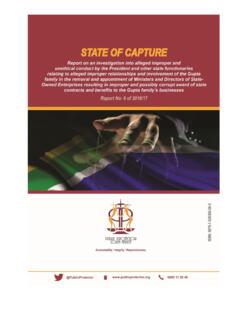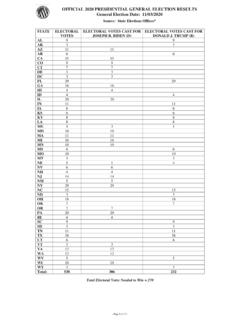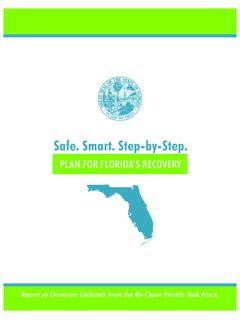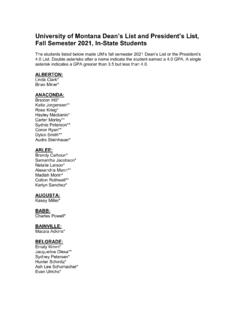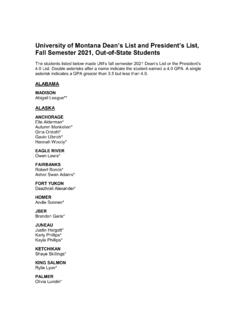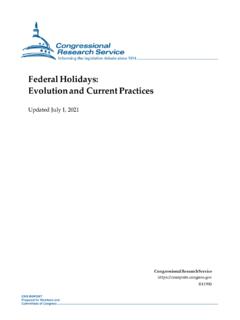Transcription of The Introduction of Human Capital Theory into Education ...
1 1 The Introduction of Human Capital Theory into Education Policy in the United States Laura Holden College of Education Michigan State University Jeff Biddle Dept. Of Economics Michigan State University November 2016 Abstract Prior to 1958, Human Capital was little more than a suggestive phrase in economics, and played no role in discussions of Education policy. Within five years, there was an active theoretical and empirical Human Capital research program in economics. Over the same period, the new idea of public spending on Education as a form of investment with a demonstrably high rate of return, and the capacity to contribute to the achievement of important national goals, was enthusiastically communicated to the public by opinion leaders, policy makers, and even a president .
2 This paper discusses two reasons why the Human Capital idea so rapidly came to influence Education policy: (i) the Human Capital idea implied that policies promoting Education could advance goals first faster economic growth, then poverty reduction -- that circumstances pushed to the top of the nation s policy agenda during the period of Human Capital Theory s initial development; and (ii) an advocate of the Theory who could persuasively explain the logic and the emerging empirical evidence linking Education to those goals moved into a position of power and influence. We also suggest that this episode marks the beginning of, and was a contributing factor to, a profound transformation of the public discourse surrounding Education policy in the United States.
3 2 I propose to treat Education as an investment in man and to treat its consequences as a form of Capital . Since Education becomes a part of the person receiving it, I shall refer to it as Human Capital . Thus did Theodore Schultz begin his 1960 article on Capital Formation by Education , one of the initial products of a research program that Schultz had been pursuing since the mid 1950s. In the late 1950s and early 1960s Schultz played a crucial role in converting this idea of Human Capital from a suggestive metaphor to the basis for a wide-ranging and fruitful research program in He did so through his own work, and also through his efforts to encourage and facilitate research by young economists, including Gary Becker and jacob Mincer, into questions raised by the Human Capital Schultz s metaphor of Human Capital was quickly embraced by economists.
4 And those outside the profession also perceived it as new way of thinking about Education being advocated by a social science that had previously given little systematic attention to the It is not the rapid acceptance of the Human Capital idea by economists that concerns us in this paper, however. Rather, our subject is how this new way of thinking, and the formal theoretical framework that developed out of it, rapidly became prominent in discussions of federal Education 1 This paper focuses on the emergence and adoption of the Human Capital idea as a framework for thinking about Education and Education policy. However, Schultz also included health care, on-the-job training, and migration for better job opportunities as forms of Human Capital investment, and the analysis of these activities was part of the Human Capital research program in economics from its inception (Schultz 1961, p.)
5 1; Schultz 1962). 2 In the late 1950s, Schultz was chair of the Chicago economics department and an influential figure within the profession. Upon learning of Mincer s research on Human Capital investments and income distribution, he arranged a post doc for Mincer at Chicago (1956-57). Schultz played a role in the process by which Gary Becker came to work on a Carnegie Corporation-funded NBER project out of which grew Becker s Human Capital ; and he encouraged, commented on, and promoted Becker s work at every stage along the way. Becker made clear his debt to Schultz in the Preface to Human Capital , and elsewhere ( , his interview with Russ Roberts at ). Schultz also organized the 1961 NBER Conference on Investment in Human Beings (Schultz 1962), at which many of the seminal papers of the Human Capital research program were presented (Teixeira 2006, 2010, 2011).
6 3 Schultz asserted the novelty of the Human Capital idea in his 1960 AEA presidential address (Schultz 1961, p. 1), but acknowledged that the idea was present in Adam Smith. Kiker (1966) later identified it in the work of other prominent economists of the past. However, prior to the late 1950s, thinking of certain activities that increased the inherent productivity of individuals as akin to investment in a form of Capital had never become the basis of a substantial body of economic Theory , nor was it central to economists thinking about the role of the labor in production and distribution. 3 policy, and began to be used to shape and motivate federal economic policy in the United States. We believe that this is an interesting story for at least two reasons.
7 First, such an immediate policy impact of a conceptual/theoretical innovation in economics is unusual. It is more often the case that novel theoretical frameworks and associated policy agendas which capture the imagination of economists are ignored for decades before being taken up by those who actually have the power to make policy, if they are ever taken up at all. We argue below that the surprisingly quick migration of the Human Capital idea from the technical literature of economics to the public comments of US Presidents and their top policy advisors was facilitated by a convergence of political, economic and cultural trends in the post-war decades that combined to make political actors particularly receptive to Schultz s message about Human Capital .
8 Schultz s version of the Human Capital idea can in turn be seen as his reaction to efforts by economists in the 1950s to identify the sources of economic growth, a reaction shaped by a set of research strategies and interests he had developed over his career. We also document the key role in bringing the Human Capital idea into discussions of Education policy played by the influential economist Walter Heller. For Heller, Schultz s redefinition of Education as investment in Human Capital , and his hypotheses about the relationship between Human Capital accumulation and aggregate economic growth, formed the basis for arguments that funding for Education should be increased, and that the Federal Government was responsible for providing that increased funding.
9 These arguments were ultimately accepted by John F. Kennedy and Lyndon B. Johnson, US presidents under whom Heller served as chairman of the Council of Economic Advisers (CEA). Second, although our narrative ends in 1965 with the passage into law of the educational policies associated with the War on Poverty, we suggest that the events we describe contributed 4 to a profound transformation of the discourse surrounding Education policy in the United States. Three assumptions that today underlie Education policy discussions in the US are that the Federal Government has an important role to play in both funding and regulating public Education ; that the central purpose of Education is to increase students future productivity and earnings capacity, and that economists possess expert knowledge that gives them important insights into the educational process.
10 These assumptions were not widely accepted in Education policy circles in the 1950s; that they are so now is, we believe, partly due to Heller s successful promotion of Schultz s Human Capital idea. In the next section of the paper we give an account of how, in the years following WWII, increasing the rate of economic growth became the paramount goal of US economic policy. We then describe the empirical research aimed at explaining economic growth being done by economists during the same period. We explain how Theodore Schultz s decision to begin a research program focused on investment in Human Capital and its relationship to economic growth was in part a reaction to this research, although it also grew out of his work in agricultural economics prior to 1955.

